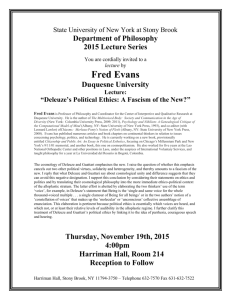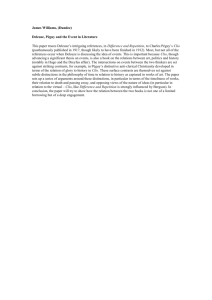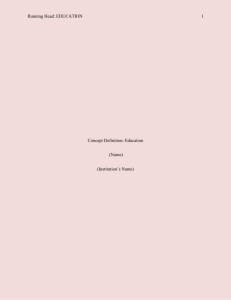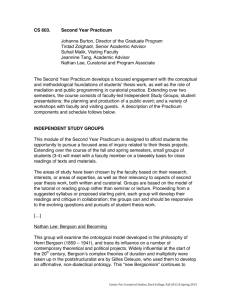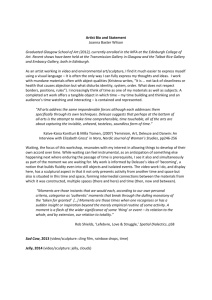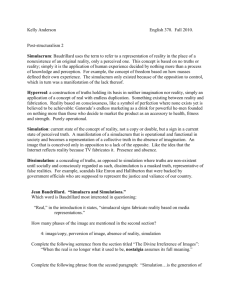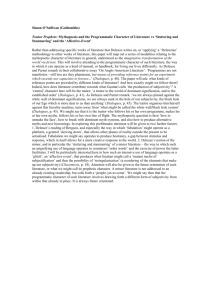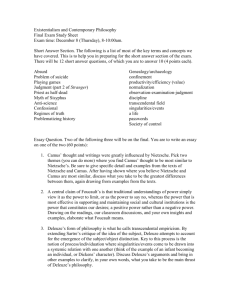Reversible Terrain: Point of View in Kan Xuan's "Nothing!" (2004) Jacquelyn Ross
advertisement
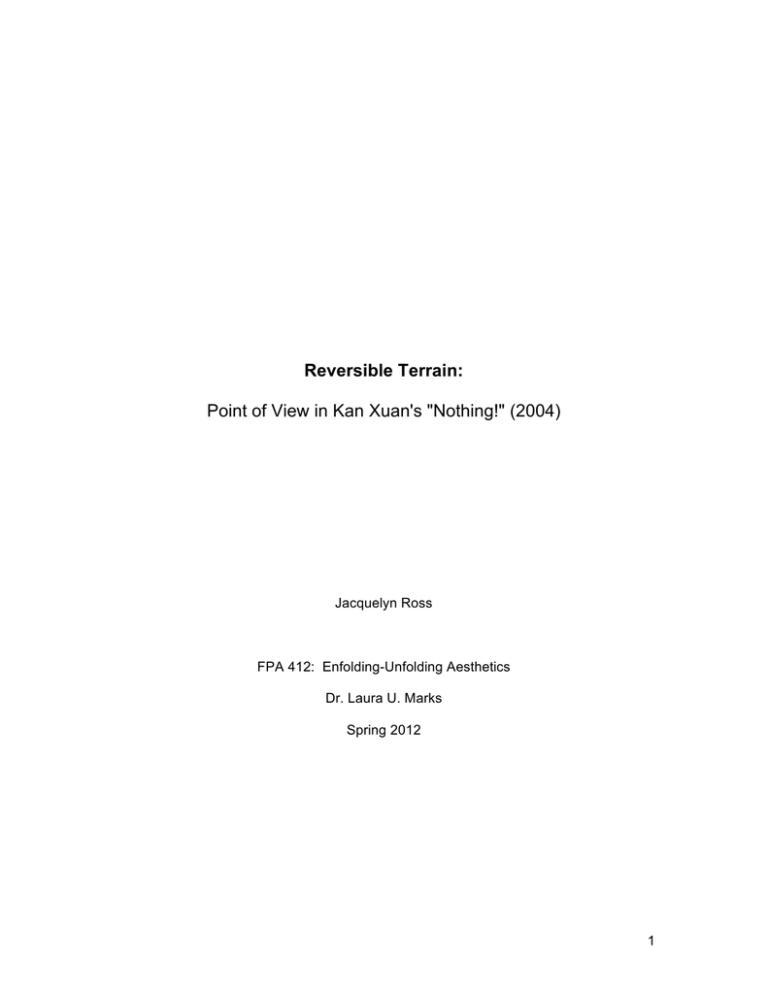
Reversible Terrain: Point of View in Kan Xuan's "Nothing!" (2004) Jacquelyn Ross FPA 412: Enfolding-Unfolding Aesthetics Dr. Laura U. Marks Spring 2012 1 Kan Xuan, "Nothing!" (2004), film still There is much to be said about the process of looking for something, of searching, and not finding it. Where the world is shaped by one's point of view but also acts on it, the act of perceiving the world is both interior and exterior, and at once foreign, and familiar. What could be drawn from the subjectivity of this experience, but also from its alienation? And what defines the 'remarkability' of this extension — between the known, and the unknown; the self, and the other — that is so driven by the desire to render the impersonal personal, and to experience fully the newness of each moment, however fleeting? Kan Xuan's video work, entitled "Nothing!” (2004), could be seen as an attempt to investigate these questions, by establishing a unique point of view that is constantly shifting between conflicting modes of perception and expression, action and inaction. 2 An anonymous protagonist guides us on a humourous close-up exploration of shadowy nooks in sandy terrain and holes in concrete retaining walls, each time expressing its surprise in a squeaky, otherworldly voice, and exclaiming "Nothing!" before moving on to the next site. The camera becomes an eye which reveals a seemingly first-person account of this erratic topographical journey, quivering in and out of focus, and moving unpredictably and frantically across surfaces, textures, and colours in search of holes in the ground which are obviously 'something'. There is no inside or outside, objective or subjective. Instead, what becomes clear is that these images are part of an unfolding reality that is parallel to our own, a reality in which what is deemed 'notable', to use Deleuze's term, seems to break away from the everyday along entirely different lines. Foreign, yet familiar. Like the creation of mountains and valleys, the folding and unfolding of a single plane produces reversible relations, each yielding its own perspective. How else might we describe this continuum of matter, of which we can only see one side? Is there some expanded sense by which we can describe the experience of moving across folded planes, as a terrain described by action, and of movement? MATTER IN MOVEMENT, THE UNIVERSE AS TOPOGRAPHY It seems that no one understands the lay of the land more astutely than the ant. Navigating wildly unpredictable and unknown territory, the ant as explorer of new frontiers and master of smell and touch scours the land in search of food and shelter with only the use of its antennae and a limited near-sightedness which guides between light and dark.1 The landscape becomes pure surface: opening up to new spatial relations 1 Julian Huxley, Ants (New York: J. Cape and R. Ballou, 1932), 36. 3 where laws of gravity no longer apply, and every movement is simply 'directional' in the loosest possible meaning of the word. I recall a simple drawing exercise from my youth, where we were instructed to draw contours of objects by imagining that the tip of our pencil was an ant crawling around on the object's surface. The results were drawings which engaged not so much with an optical extension, but rather, with a tactile one. The eye becomes an ant tracing an imagined topography in painstaking detail, and with such attention to the tiny deflections of a route that the drawing becomes more about a process or journey than any distinct representation or finished work. In a similar vein, Julian Huxley, in his 1932 book on ants, writes of the unique sense of scale and texture that guides the specificity of an ant's experience of the world: "As Espinas pointed out...'on the earth there is not a contact that does not yield precise information.' We may add that the obstacles to be constantly overcome (think what a formidable jungle is the grass to an ant dragging its prey, what an Amazon is every streamlet!) must provoke the development of perseverance in ingenuity."2 Out of careful observation comes creativity, adaptation, and ingenuity. In Kan Xuan's work, too, the experience of the topography seems guided by the tip of some invisible pencil which moves dynamically across surfaces as a way of describing their texture, and, fundamentally, also their essence. The camera-eye 'writes' these instances at the same time as it experiences them, creating a kind of unfiltered collage of sensorium and chance focal points. It is an experiential collection of movement and matter, endlessly forming and deforming. Like the vibrations that are endlessly travelling within and between materials and the body, perception is fundamentally unstable, caught in a perpetual state of becoming: "what [perceptions] resemble is neither extension nor even movement, but matter in 2 Ibid., 13. 4 Kan Xuan, "Nothing!" (2004), film still extension, vibrations, elasticities, 'tendencies or efforts' in motion. Pain does not represent the pin in extension, but resembles molecular movements that it produces in matter."3 For Deleuze, these elastic vibrations are received by our receptive organs, at which point they reach consciousness as the sum of many tiny parts or 'minute perceptions' that make up the real in matter. The totality of what we perceive at any given instant consists of these tiny vibrations and reflections, just as the colour white in fact consists of "an infinity of 'little convex mirrors such as there are seen in foam when we look at it closely.'"4 3 Gilles Deleuze, The Fold: Leibniz and the Baroque, trans. Tom Conley (Minneapolis: University of Minnesota Press, 1993), 96. 4 Ibid., 95. 5 Thus if vibrations can be understood as a system of microscopic reflection and deflection, there must be continuous exchange, whether it be between the earth, the air, the eye, the antennae, the body, the organs, or the camera. Pointing to the interconnectedness of the internal and the external within perception, the folded plane opens up to a traversable terrain where matter is defined through the process of moving and extending along deflections. It is as if the end of a thread was thrown out in a wavering line, and allowed to move and be moved by the air before falling back into itself. What is this vibrating thread, this connection, that binds each monad to the infinite? Like the antennae of ants, "Nothing!" suggests a situation in which the viewer's organs might lie outside of our bodies, as the first point of contact between ourselves and the world, independently mobile and utterly vulnerable. Might it be possible that our organs actually lie inside the frame of the video, moving along this new terrain as an extension of our projected self? And how might we navigate this new space, so alienated from our bodies yet so close to our senses? There is much that we can learn from ants about non-visual navigation. Unlike humans, ants rarely navigate based on their orientation to objects in the landscape, but rather rely strongly on smell to follow pre-defined trails, and establish an instinctual sense of direction according to "the direction of the light falling upon them."5 Thus, like ants wayfinding along the edges of concrete and intuitively locating themselves with the position of the sun, affective and perceptive relationships with the terrain become paramount, and sense faculties are heightened. For Bergson, our sense of direction is highly dependent on perception and affection, and, being tailored to the body as a privileged zone which perceives only according to its needs, it is unique to the individual. Images derived from our sense 5 Huxley, Ants, 38. 6 experiences are 'absorbed' by the body and 'reflected' in action, forming a complex system of images defined through movement, constantly acting and reacting on each other.6 It is in this way that our senses might direct us, marking a path that is defined by our body's point of view, and reflecting our virtual acts in what we perceive of our surroundings. Through the process of perception, the impersonal is internalized, and the personal is projected. The body, as an imperfect vessel of past memories and present needs, struggles with this projection of itself, for as Bergson writes, "this centre is not a mathematical point; it is a body, exposed, like all natural bodies, to the action of external causes which threaten to disintegrate it...It does not merely reflect action received from without; it struggles, and thus absorbs some part of this action. Here is the source of affection."7 Kan Xuan's work finds something in common with this struggle, between actual and virtual actions, absorption and reflection, that is so fundamental to human experience. What happens within this attempt to extend affection, from interiority to exteriority? Could this be, in fact, the source of conception? A HOLEY GROUND LEADS TO UNDERSTANDING Forever in a state of focusing and falling out of focus again, the protagonist in the video expresses an obsession. "Nothing!" is full of holes. A hole is at once a void, a gap, a burrow, a container, a shelter, a refuge, a vacuum, a source of shade, a route, a vessel, a hollow, an instrument, a cavity, a tunnel, a peephole, a den, a crack, a flaw, a cell or a well. A hole is, by its very nature, openended: full of multiple readings and uses, and varying in size, texture, material or even 6 Henri Bergson, "Images and Bodies," in Henri Bergson: Key Writings, ed. Keith Ansell Pearson and John Mullarkey (New York: Continuum, 2002), 86, 111. 7 Ibid., 110-111. 7 timbre. It is spatial, but also lacking depth, for nowhere is the lack of depth awareness more pronounced than in the flat blackness of a dark tunnel or a cave. A hole is symbolic of the unknown, and it points to the limits of visibility, or even knowability. Where there is an absence of light, however big or small, the mind wanders. A hole is nothing, and it is something. I am reminded of an image Deleuze and Guattari mention briefly in their "Treatise on Nomadology" of a scene from Eistenstein's 1925 film Strike, depicting "a holey space where a disturbing group of people are rising, each emerging from his or her hole as if from a field mined in all directions."8 This image is imprinted on my mind, too: the graininess of the black and white footage, scratched into the surface of the film like the holes in the earth it describes; so many ordinary people emerging from their individual concrete tunnels like a colony of nocturnal animals, squinting unremarkably in the daylight. For Deleuze and Guattari, these early metallurgists inhabit a 'subsoil' that might negotiate between the 'smooth space' of the nomad and the 'striated space' of the sedentary. Penetrating the sedimentary layers built up over history, and lying outside the confines of state control, they seem to inhabit a kind of transgressive position of being in-between. "Turn the earth into swiss cheese."9 I can't help but feel that this is also what Kan Xuan is doing. Where material reality becomes vacuous and penetrable, does it not make us question also the solidity of things, and inversely, their potential hollowness? And is this not curiously parallel to the nature of the fold, where each surface becomes referential of its inverse, even if the opposite side remains invisible or inaccessible? 8 Gilles Deleuze and Félix Guattari, "Treatise on Nomadology - The War Machine," in A Thousand Plateaus: Capitalism and Schizophrenia, trans. Brian Massumi (Minneapolis: University of Minnesota Press, 1987), 413-414. 9 Ibid., 413. 8 Perhaps in this case it is plausible also to deduce the invisible from the visible, and draw from what is given, in order to make meaning. The holes in "Nothing!" are not generalized, for in fact they are quite specific. So where do these holes exist, and for what purpose? Each hole is different, but similarities between them suggest not a random selection, but a deliberate one. The camera shows Kan Xuan, "Nothing!" (2004), film still an amazing assortment of holes of slightly varying sizes occupying what appears to be a retaining wall of some kind. Somewhere hot, bright, and dry. Upon further research, it seems that the holes resemble 'weep holes' typically found in masonry infrastructure: drainage holes built into walls at periodic intervals to release pressure and collecting groundwater from behind the wall. It is curious then, that in Xuan's video, the pipes run dry, and seem to find a variety of alternative uses. Rather 9 than release water, the holes instead act as a type of attraction, where people hide their garbage, junk food wrappers, or cigarette butts, and which subsequently become a destination for insects and other small animals looking for food or shelter. In newer architecture, weep holes no longer need to drain directly to the outside, as groundwater is increasingly piped invisibly underground or within buildings, collecting in concentrated units before draining from a single pipe at a desired location. But what will happen to these indirect events? Just as a privileged function finds new means, everything must adapt. A procession of ants reroutes. For just as the holes are teeming with multiplicity, so are the walls, which seem to be made up of a combination of packed earth and concrete mortar, patched together in irregular, non-linear configurations that seem remarkably counter-intuitive, even improvised. It is puzzling to try to understand how the mortar joints are made, producing questions which must work backwards to consider both materiality and process. Surely filling the gaps between blocks of stone would not yield such straight-edged results, but packed earth would not call for such a fragmented surface. My reasoning fails to grasp the rationale which might call for this type of production, for wouldn't it have been easier to build a wall in horizontal rows? The whole construction appears to be sliding. At its very essence it seems to constitute a kind of 'machinic phylum' by which matter expresses "an entire energetic materiality in movement, carrying singularities or haeccities that are already like implicit forms...and that combine with the forces of deformation."10 The historical and technological lineage which has attributed to the present existence of the structure is evident in every obscure detail that traces its mode of production. They are pieces that perhaps remain unknown, but are still present, just as the video's point of view exposes its most personal and subjective details, while its subject remains obscure. Who is it that we are looking through, and following in their 10 Ibid., 403. 10 desperate search for something, anything? Of all that is singular, is there anything that can be shared? To whom do we extend our intersubjectivity? STANDING AT THE EDGE EXPOSES THE OTHER (SIDE) As Deleuze writes of the extent of the Leibnizian monad, "every monad thus expresses the entire world, but obscurely and dimly because it is finite and the world is infinite."11 The monad, who establishes its privileged 'clear zone' by perceiving only what is closest to it and what it deems 'remarkable', is a body like any other, who perceives according to its needs and interests. Elsewhere Deleuze goes further to explain that it is in this way that an atom in fact perceives more of the world than a human being, for it makes fewer selections about what it perceives.12 Thus our view is limited, but uniquely so. Like the experience of standing at the edge of a dark hole and peering down, it is consciousness that makes us acutely aware of the edge, while the depth of the hole plunges into a flat darkness, dim and evasive. As the definitive centre of what Bergson termed our 'zone of indetermination'13, it seems we are forever trapped within the impossibility of approaching the edge of ourselves. Our subjectivity, as shaped by our perceptions of the world, establishes a point of view that perpetually readjusts itself to situate us at its heart. However, it may still be useful to imagine, as a kind of thought experiment, the potentiality of approaching the edge of our point of view; to separate ourselves, for a moment, from the mind which conceptualizes our perspective, and to allow the body to stand at the outer rim of our experience and look across into another's. For does not Kan Xuan's work challenge the 11 Deleuze, The Fold, 86. Gilles Deleuze, Cinema 1: The Movement-Image, trans. Hugh Tomlinson and Barbara Habberjam (Minneapolis: University of Minnesota Press, 1986), 78-79. 13 Bergson, "Images and Bodies," 95. 12 11 viewer to do precisely this? Within each monad lies a curious in-between ground, somewhere between clarity and darkness, that allows for a degree of overlap or shared territory, and it is here that I would propose we might situate an understanding of A Reversible Point of View: intersubjective experience. Like extending our point of view out into the video's holey terrain, intersubjectivity requires an extension of both mind and matter into the grey areas of our existence. Merleau-Ponty's notion of reversibility becomes a useful strategy to examine alterity, and sheds light on the way in which one might embody an alternative viewpoint. As he observes in The Visible and the Invisible, the gap between 'seeing' and 'being seen', or 'touching' and 'being touched', is such that the experience is allowed to both 12 overlap and diverge.14 Each half of the event implies a reversible relationship to the other, but the subject cannot experience both at the same time. We can apply this concept of reversibility also to an understanding of points of view, in which reversible relations might constitute a kind of messy 'monadic tiling': each concave edge not only defining the convex edge of its neighbour, but being further defined by an overlapping gradient that extends from each monad's 'clear zone' outwards, dimmer and dimmer, until it eventually becomes the 'clear zone' of another. Drawing from this reversible principle, the viewer extends him or herself into the plane of the film, inhabiting a territory that is dim, but accessible. This extension, of body and subjectivity, in fact forms the inverse of an other's 'clear zone', and it is in this way that the viewer is able to access the space of this curious stranger in their search for the unknown. What is Kan Xuan's character expecting to find? What might fill this absence that is otherwise 'nothing'? Beyond its framing of existential questions, Kan Xuan's work engages directly with the materiality that lies at the centre of any experience of the world, taking to heart the astute observations and 'pricklings' of perception15 that constitute self-awareness. The extension required of the viewer is momentarily hindered by the paradox that matter is at once both solid and penetrable, "an infinitely porous, spongey, or cavernous texture without emptiness, caverns endlessly contained in other caverns."16 But towards an understanding of this problem, "Nothing!" provides a key — for every 'hole' is also a 'fold', and as such, it can be unfolded, traversed, inverted, and remade. 14 Maurice Merleau-Ponty, "The Intertwining — The Chiasm," in The Visible and the Invisible: Followed by Working Notes, ed. Claude Lefort, trans. Alfonso Lingis (Evanston: Northwestern University Press, 1968), 133. 15 Deleuze, The Fold, 80. 16 Ibid., 5. 13 Bibliography Bergson, Henri. "Images and Bodies." In Henri Bergson: Key Writings, edited by Keith Ansell Pearson and John Mullarkey, 86-123. London, New York: Continuum, 2002. Deleuze, Gilles. Cinema 1: The Movement-Image. Translated by Hugh Tomlinson and Barbara Habberjam. Minneapolis: University of Minnesota Press, 1986. Deleuze, Gilles. The Fold: Leibniz and the Baroque. Translated by Tom Conley. Minneapolis: University of Minnesota Press, 1993. Deleuze, Gilles and Félix Guattari. "Treatise on Nomadology - The War Machine." In A Thousand Plateaus: Capitalism and Schizophrenia, translated by Brian Massumi, 351-423. Minneapolis: University of Minnesota Press, 1987. Huxley, Julian. Ants. New York: J. Cape and R. Ballou, 1932. Merleau-Ponty, Maurice. "The Intertwining — The Chiasm." In The Visible and the Invisible: Followed by Working Notes, edited by Claude Lefort, translated by Alfonso Lingis, 130-155. Evanston: Northwestern University Press, 1968. Sanders, Michael. Merleau-Ponty: Key Concepts, edited by Rosalyn Diprose and Jack Reynolds, 142-151. Stocksfield: Acumen Publishing Ltd., 2008. 14
